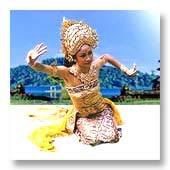When someone encounters a Balinese high priest (pedanda) in action, one can hardly miss the beauty of his or her hand gestures. This hand gestures are known as mudra. Mudra has been used by both Hindu and Buddhist priests for thousands of years. The word “mudra” means “sign” when the high priest utters the sacred incantation, his or her hands make certain gestures as signs to express the words of sacred incantation with movements.
In Bali mudra is called “patanganan”, or movement of the hand. These hand movements are part of three elements that must unite in order to communicate with God. These three element are mind (the memory of sacred incantation (mantra), voice (the utterance of sacred incantation), and movement (hand gesture that translate the sacred incantation into movement).
Balinese high priest use mudra in officiating a ceremony or cleanse his mind before officiating a ceremony. Mudra is also used for welcoming God, presenting offering to God, achieving something, or increasing healthiness of the body.
It is said that the Balinese dances is made based on the beauty of the mudra. But the most obvious influence of mudra can be found in the ancient statues of Bali. The hands of these statues were made various kind of mudra (sacred gestures) for example cin mudra (hand gesture to calm the restless mind), vakhayana mudra (hand gesture when speaking), sudarsana mudra (hand gesture when giving instruction), jnana mudra (hand gesture of contemplation), dhyana mudra and yoga mudra (hand gesture of meditation), vitarka mudra (hand gesture when giving lesson), bodhyagiri mudra (hand gesture when holding something), bhumisparsa mudra (hand gesture of calming the world), vara mudra (hand gesture of giving a bless), abhaya mudra (hand gesture of removing all obstacle), vismaya mudra (hand gesture of dismay), anjali mudra (hand gesture of giving homage), suci hasta mudra (hand gesture of pointing something), etc. (BALIwww)












